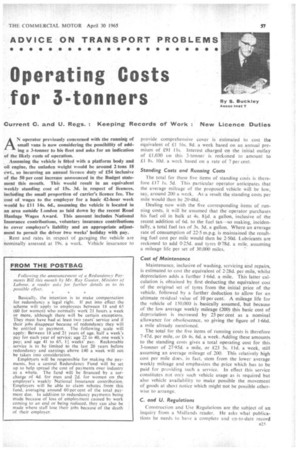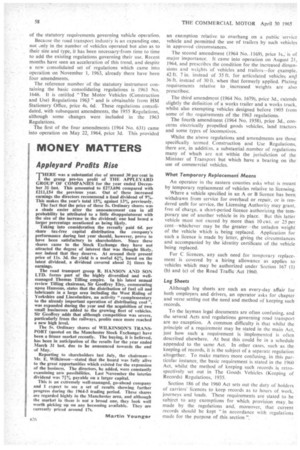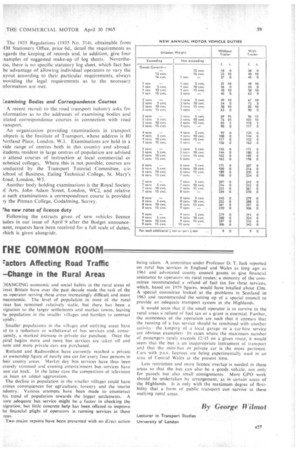Operating Costs for 3-tonners
Page 59

Page 60

Page 61

If you've noticed an error in this article please click here to report it so we can fix it.
Current C. and U. Regs. : Keeping Records of Work : New Licence Duties AN operator previously concerned with the running of small vans is now considering the possibility of adding a 3-tanner to his fleet and asks for an indication of the likely costs of operation.
Assuming the vehicle is fitted with a platform body and oil engine, the unladen weight would be around 2 tons 18 cwt., so incurring an annual licence duty of £54 inclusive of the 50 per cent increase announced in the Budget statement this month. This would result in an equivalent weekly standing cost of 15s. 3d. in respect of licences, including the small proportion of carrier's licence fee. The cost of wages to the employer for a basic 42-hour week would he £11 14s. 6d., assuming the vehicle is located in an area outside London as laid down by the recent Road Haulage Wages Award. This amount includes National Insurance contributions, voluntary insurance contributions to cover employer's liability and an appropriate adjustment to permit the driver two weeks' holiday with pay.
Rent and rates in. respect of garaging the vehicle are nominally assessed at 19s. a week. Vehicle insurance to provide comprehensive cover is estimated to cost the equivalent of £1 16s. 8d. a week based on an annual premium of £91 I Is. Interest charged on the initial outlay of £1,030 on this 3-tonner is reckoned to amount to £1 8s. 10d. a week based on a rate of 7 per cent.
Standing Costs and Running Costs
The total for these five items of standing costs is therefore £17 Is. 5d. This particular operator anticipates that the average mileage of the proposed vehicle will be low, say, around 200 a week. As a result the standing costs per mile would then be 20-48d.
Dealing now with the five corresponding items of running costs, it will be assumed that the operator purchases his fuel oil in bulk at 4s. 80. a gallon, inclusive of the recent addition of 6d. to the fuel tax—so making, incidentally, a total fuel tax of 3s. 3d, a gallon. Where an average rate of consumption of 22.5 m.p.g. is maintained the resulting fuel cost per mile would then be 2-50d_ Lubricants are reckoned to add 0-25c1_ and tyres 0-78d. a mile, assuming a mileage life per set of 30,000 miles.
Cost of Maintenance Maintenance, inclusive of washing, servicing and repairs, is estimated to cost the equivalent of 2-28d. per mile, whilst depreciation adds a further 1-66d. a mile. This latter calculation is obtained by first deducting the equivalent cost of the original set of tyres from the initial price of the vehicle, followed by a further deduction to allow for an ultimate residual value of 10 per cent. A mileage life for the vehicle of 150,000 is basically assumed, but because of the low average weekly mileage (200) this basic cost of depreciation is increased by 25 per cent as a nominal allowance for obsolescence, so giving the figure of 1-66d. a mile already mentioned.
The total for the five items of running costs is therefore 7.47d. per mile, or £6 4s. 6d. a week. Adding these amounts to the standing costs gives a total operating cost for this 3-tonner of 27-95d, a mile, or £23 5s. I Id. a week, still assuming an average mileage of 200, This relatively high cost per mile does, iri fact, stern from the lower average weekly mileage and emphasizes the price which has to be paid for providing such a service. In effect this service constitutes not only such vehicle usage as is required but also vehicle availability to make possible the movement of goods at short notice which might not he possible otherwise to arrange.
C. and U. Regulations Construction and Use Regulations are the subject of an inquiry from a Midlands reader. He asks what publications he needs to have a complete and up-to-date record
of the statutory requirements governing vehicle operation.
Because the road transport industry is an expanding one, not only in the number of vehicles operated but also as to their size and type, it has been necessary■from time to time to add the existing regulations governing their use. Recent months have seen an acceleration of this trend, and despite a new consolidated set of regulations which came into operation on November 1, 1963, already there have been four amendments.
The reference number of the statutory instrument containing the basic consolidating regulations is 1963 No. 1646. It is entitled "The Motor Vehicles (Construction and Use) Regulations 1963 " and is obtainable from HM Stationery Office, price 4s. 6d. These regulations consolidated, with subsequent amendments, the 1955 Regulations, although some changes were included in the 1963 Regulations.
The first of the four amendments (1964 No. 631) came into operation on May 22, 1964, price 3d, This provided an exemption relative to overhang on a public service vehicle and permitted the use of trailers by such vehicles in approved circumstances.
The second amendment (1964 No. 1169), price Is., is of major importance. It came into operation on August 21, 1964, and prescribes the condition for the increased dimensions and wciehts of vehicles and trailers—for example, 42 ft. 7 in. instead of 35 ft. for articulated vehicles anti 36 ft. instead of 30 ft. when that formerly applied. Plating requirements relative to increased weights are also prescribed.
The third amendment (1964, No. 16-79), price 3d., extends
slightly the definition of a works trailer and a works truck, whilst also exempting vehicles designed before 1905 from some of the requirements of the 1963 regulations.
The fourth amendment (1964 No. 1958), price 3d., concerns electrically propelled goods vehicles, land tractors and some types of locomotives.
Whilst the above regulations and amendments are those specifically termed. Construction and Use Regulations, there are, in addition, a substantiatnumber of regulations many of which are not within the jurisdiction of the Minister of Transport but which have a bearing on the use of commercial vehicles.
What Temporary Replacement Means An operator in the eastern counties asks what is meant by temporary replacement of vehicles relative to licensing.
Where a vehicle specified in an A or B licence has beer. withdrawn from service for overhaul or repair, or is rendered unfit for service, the Licensing Authority may grant, free of charge, a short-period licence authorizing the temporary use of another vehicle in its place. But this latter vehicle must not exceed by more than 10 cwt. or 25 per cent— whichever may be the greater—the unladen weight of the vehicle which is being replaced. Application for such a licence is made by letter, giving the circumstances and accompanied by the identity certificate of the vehicle being replaced.
For C licences, any such need for temporary replacement is covered by a hiring allowance as applies to vehicles which may be authorized under Section 167 (1) (b) and (c) of the Road Traffic Act 1960.
Log Sheets Although log sheets are such an every-day affair for both employers and drivers, an operator asks for chapter and verse setting out the need and method of keeping such records.
To the layman legal documents are often confusing, and the several Acts and regulations governing road transport are no exception. A common difficulty is that whilst the principle of a requirement may be stated in the main Act, just how such a requirement is implemented is often described elsewhere. At best this could be in a schedule appended to the same Act. In other cases, such as the keeping of records, it is the subject of a separate regulation altogether. To make matters more confusing, in this particular instance, the basic requirement is stated in the 1960 Act, whilst the method of keeping such records is retrospectively set out in The Goods Vehicles (Keeping of Records) Regulations, 1935.
Section 186 of the 1960 Act sets out the duty of holders of carriers licences to keep records as to hours of work, journeys and loads. These requirements are stated to be subject to any exemptions for which provision may, be made by the regulations and, moreover, that current records should be kept " in accordance with regulations made for the purpose of this section ". The 1935 Regulations (1935 No. 314), obtainable from -1M Stationery Office, price 6d., detail the requirements as :egards the keeping of records and, in addition, give four :xarriples of suggested make-up of log sheets. Nevertheess, there is no specific statutory log sheet, which fact has he advantage of allowing individual operators to vary the ayout according to their particular requirements, always )roviding the legal requirements as to the necessary nformation are met.
Examining Bodies and Correspondence Courses
A recent recruit to the road transport industry asks for nformation as to the addresses of examining bodies and -elated correspondence courses in connection with road ransport.
An organization providing examinations in transport ubjects is the Institute of Transport, whose address is 80 'ortland Place, London, W.I. Examinations are held in a vide range of centres both in this country and abroad. ;tudents resident in large centres of population are advised
o attend courses of instruction at local commercial or echnical colleges. Where this is not possible, courses are :onducted by the Transport Tutorial Committee, c/o ;chool of Business, Ealing Technical College, St Mary's toad, London, W5.
Another body holding examinations is the Royal Society if Arts, John Adam Street, London, WC2, and relative
o such examinations a correspondence course is provided iy the Pitman College, Godalming, Surrey.
rhe new rates of licence duty
Following the extracts given of new vehicles licence luties in our issue of April 9 after the Budget announcenent, requests have been received for a full scale of duties, vhich is given alongside.




































































































